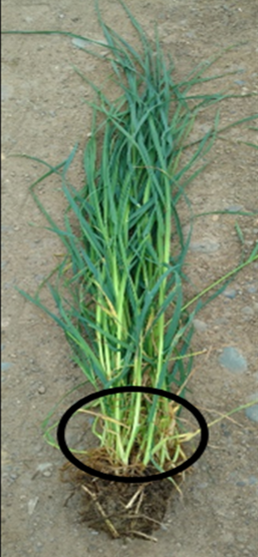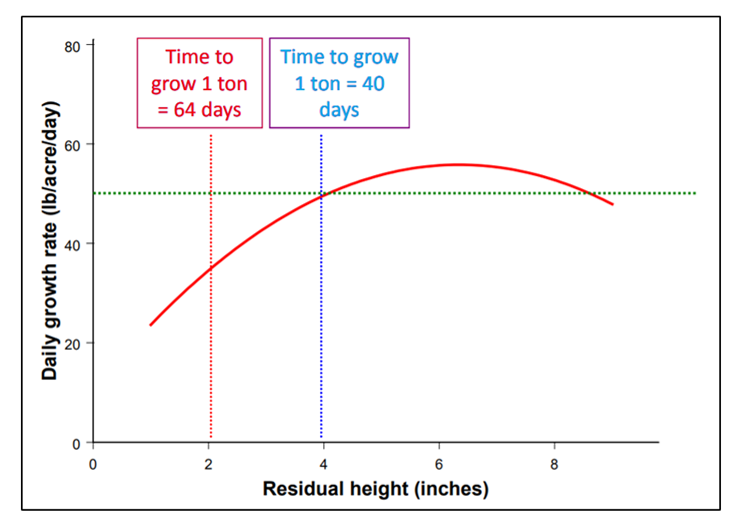
Focal point
|
When it comes to production of harvested forages like hay or baleage, stand decline is a common issue many producers face. Unfortunately, like most things there is no simple answer to eliminate issues with stand decline. Poor soil fertility, disease, temperature, moisture, and weed pressure are all things that can play a role in the longevity of a stand. While some of these things may be out of our control, one thing that producers do have full control over is cutting height. If you want to harvest higher quality forages, have better regrowth, and improve stand longevity, pay attention to your cutting height.
Compared to the older style sickle bar mowers, the advent of the disc mower allows producers to cut forages very close to the ground, perhaps at times even scalping the surface at ground level. While cutting forages as low as possible will increase forage yield for a particular cutting, this isn’t always the best practice and cutting too low can lead to several negative consequences.
Reduced Stand Longevity
The first potential consequence is a reduction in stand longevity. After forages are cut, they have two main sources of energy to use for regrowth. The first source of energy is remaining leaf area, which is able to photosynthesize and produce energy for the plant. The second source of energy is stored energy reserves; for many of our predominant forages, this energy reserve is found in the base of the stem and tillers (i.e. the lowest 2-4 inches of the plant; Figure 1). When a forage crop is cut too low, not only are we not leaving much leaf area for photosynthesis, we are also removing most of that plant’s stored energy reserves. As a result, the plant becomes stressed. Stressed plants take longer to regrow, which may actually result in a decrease in season-long yields.
“...that extra inch or two doesn’t provide a whole lot of extra tonnage, and the positives from leaving it in the field far outweigh the negatives.“

If the forage continues to be mowed short on a consistent basis, the plant is stressed a little more each time. A forage stand that has repeatedly been mowed short and is under stress will not only be slower to regrow but it will be much more susceptible to other stressors like hot temperatures and potential drought. A short cutting height also exposes more soil to the sun, increasing soil temperatures, decreasing soil moisture retention, and providing opportunities for weeds or undesirable species to fill in, each of which adds additional layers of stress on the plant. Altogether, this is where stand longevity can start to become compromised. Numerous research studies have shown that the amount of residual remaining after cutting height has a direct influence on the persistence of forage stands over time, particularly cool-season grasses such as tall fescue or orchardgrass.
Conversely, cutting higher and leaving a little more residual forage in the field will improve the health of both the forage and the soil and reduce the presence of weeds, leading to a thicker stand of desirable grasses and greater long term productivity. With a higher cutting height, regrowth will happen much faster due to the additional leaf material left in the field. Research has demonstrated that residual height impacts the daily growth rate of forages, with forages cut at 4 inches growing back much faster compared to forages cut at 2 inches (Figure 2).

Figure 2. A line graph that shows the Effect of residual height on daily growth rate(lbs/acre/day) of cool-season grass forage (Source: Jim Gerrish, University of Missouri forage Systems Research Center.)
Decreased Forage Quality
A second consequence from a lower cutting height is decreased forage quality. The top portions of the canopy contain a higher percentage of leaves and digestible nutrients, while the lower portions of the canopy are stemmier and higher in fiber. As a result, a lower cutting height diminishes overall forage quality because more of the low quality, fibrous material is included.
Whether you are doing custom work or baling hay for your own use, quality should be as important as quantity. A large majority of the hay produced across the U.S. is low to average in quality. As an example, a recent analysis of more than 14,000 hay samples submitted to the Kentucky Department of Agriculture’s forage testing program across 10 years found that only 12% of the samples tested would meet the energy requirements of a lactating brood cow (Teutsch, UK). Small differences in forage quality and digestibility can translate to large improvements in animal production, and a timely harvest and appropriate cutting height can play a large role in achieving greater forage quality.
Raising your cutting height up and inch or two may seem like you are leaving forage in the field, but that additional inch or two might not contribute to the total yield as much as you would think. A University of Wisconsin study found that the tonnage gained for each additional inch of forage cut only added about 0.13 tons/acre in yield across a three-cut season. What is more affected is forage quality. Therefore, the amount of yield lost must be weighed against the amount of quality gained if a higher cutting height is used.
Increased Ash Content
The third consequence for mowing too close to the ground is increased ash content of the forage. Naturally, forages contain an ash content of approximately 6 to 8%. However, mowing too closely, particularly with disc mowers, can inadvertently add additional soil to the crop. This can increase the ash content by as much as 10 to 12%, ultimately leading to ash concentrations of up to 18%. Ash is made up of silica, not nutrients or minerals, and each 1% of additional ash content reduces the total digestible nutrient content of the forage by 1%. A higher cutting height will minimize contamination and keep total ash concentrations under 10%.
Minimum Cutting Height Recommendations
So all that said, what is an appropriate cutting height? How low is too low? This is largely dependent on the species being grown as well as the management and goals for the field.
Legumes like alfalfa and clover store their carbohydrate or energy reserves below the ground in the taproot of the plant. As a result, they can often be mowed at a lower cutting height compared to grass forages. Some literature shows a cutting height as low as 1 inch will increase alfalfa forage yield without reducing stand longevity. If plants are healthy and not under stress (adequate moisture, adequate nutrients, disease-free), a shorter cutting height will have less impact on stand longevity. However, frequent cutting of alfalfa at an early maturity using low cutting heights often depletes root carbohydrate reserves, which can end up reducing stand life if other stress factors exist. Also, remember that a low cutting height comes with an increased risk for decreased forage quality and increased ash concentrations, particularly with a disc mower. Current recommendations are to cut alfalfa or clover at a 2-3 inch minimum height to better maintain carbohydrate reserves and minimize ash contamination of the forage.
Cool-season grasses like orchardgrass, fescue, and timothy all store their energy reserves above ground in the base of the stem and tillers. This makes them much more sensitive to cutting height since a low cutting height will directly affect their remaining energy reserves. For these species, a minimum of 4 inches of residual should be left to promote rapid regrowth and maintain stand longevity. The loss in grass stand productivity from cutting too short will far outweigh any yield boost you might get from harvesting a few extra inches in a single cutting.
For mixed stands, it is usually best to manage for the dominant species. Do you have an alfalfa stand with some grass or a grass stand with some alfalfa? For alfalfa stands with some grass, a 3-inch minimum cutting height is recommended. With grasses present, it is important to keep cutting height higher than a pure stand of legumes if you want to keep the grass in the stand. For a grass stand with some alfalfa, a 4-inch minimum cutting height is recommended to ensure longevity of the grasses. In all mixed stands, cutting height can be used as a management tool for stand composition by choosing a cutting height that favors either the grass or the alfalfa.
For warm-season forages like sudangrass, sorghum sudangrass, and millet, a 6-inch minimum cutting height is recommended (if regrowth is desired). Like the cool-season grasses, these forages also store their energy reserves above ground in the base of the stem and tillers; however, the growing points for these warm-season forages are found further up the plant.
Keep in mind that these are all minimum recommendations—it is never a bad thing to mow at a higher height. The bottom line is that extra inch or two doesn’t provide a whole lot of extra tonnage, and the positives from leaving it in the field far outweigh the negatives. So the next time you start up the mower, pay attention to the cutting height of your crop and don’t be afraid to leave a little extra plant material in the field.
This article appears on June 16, 2022, Volume 3, Issue 2 of the Maryland Milk Moos newsletter and the July 2022, Issue of the Agronomy News
Maryland Milk Moo's, June 16, 2022, Vol.3, Issue 2
Maryland Milk Moos is a quarterly newsletter published by the University of Maryland Extension that focuses on dairy topics related to Nutrition and Production, Herd Management, and Forage Production. To subscribe to this newsletter, click the button below to enter your contact information.
Agronomy News, July 2022, Vol. 13, Issue 4
Agronomy News is a statewide newsletter for farmers, consultants, researchers, and educators interested in grain and row crop forage production systems. This newsletter is published once a month during the growing season and will include topics pertinent to agronomic crop production. Subscribers will receive an email with the latest edition.
Subscribe